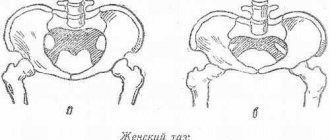How to explain the discrepancy between pregnancy dates according to ultrasound and monthly?
The availability of ultrasound diagnostics allows a woman who has just learned about her pregnancy not to speculate about the due date, but to find out exactly how her baby is developing.
Naturally, when visiting an ultrasound room, a woman roughly assumes what time the doctor will name, but it happens that her expectations are not met. How often does this happen, how can we explain the situation when the term according to ultrasound differs from the period according to menstruation, or the size of the fetus differs from the standard at a specific period?
Can ultrasound be wrong?
“Frozen pregnancy is an ultrasound error” - this is what women desperately want to hear from a doctor. But this happens quite rarely and you have to put up with the situation. Whether an ultrasound can make a mistake is quite difficult to say for sure, because each case is unique in its own way. The only thing we can say with certainty is that ultrasound diagnostics is the most reliable research method and based on its results, surgical procedures have been successfully carried out for many decades. That is why it is problematic to say that she may be wrong.
It is difficult to determine a frozen pregnancy in the first trimester, because it begins in the same way as a normal one, unlike ectopic development.
Determining a frozen fetus is a very important procedure, and the issue here is no longer a matter of a dead embryo. It will not be possible to restore pregnancy, but the point is in the embryo itself, which is in the mother’s womb. Its decomposition products can cause serious harm to a woman’s body, including death and the inability to have children in the future. It is for this reason that doctors take the timely determination of a frozen fetus so seriously; this makes mistakes quite likely, because the human factor is present everywhere.
The baby’s heartbeat can already be heard at the 5th week of pregnancy; even if outdated equipment is used, the heartbeat will be detected. Of course, there are a number of factors that can distort the diagnosis, for example, an unemptied bladder, which increases in size and prevents the study from determining the contours of the fetus. The doctor may ask the patient to go to the toilet or use a transvaginal probe. The fetus begins to move at 7-8 weeks, and the doctor also sees this on the monitor. At this time, the doctor can already determine the viability of the child, as well as its size.
An ultrasound error can occur if the equipment is outdated and the doctor is incompetent. Due to a lack of funding, most clinics use old equipment, which cannot listen to the heartbeat at 12 weeks, and the poor image obtained during the examination will only indirectly determine the size of the fetus. If this occurs, then it is likely that the doctor will prescribe a repeat ultrasound examination after 14 days. If even during the subsequent examination the heartbeat cannot be heard, then the doctor can determine a frozen pregnancy, because every day the child’s body strengthens and the main sign of vitality becomes more and more distinct.
There is also a condition called anembryonia, which is characterized by the complete absence of a fetus. An ultrasound examination will reveal that the amniotic sac is empty; this occurs at 4-5 weeks. After a woman determines pregnancy by hCG levels using a test, the fetus develops up to a certain point, and then dies and the body independently copes with its elimination, in contrast to later stages, when surgical cleansing is necessary. Of course, a woman can also seek advice from another clinic in order to refute the information received or, to her regret, confirm it.
Much more common is a situation in which a woman feels negative symptoms, and ultrasound diagnostics indicate a threat of miscarriage. In this case, medications and bed rest can preserve pregnancy.
How much can you trust ultrasound?
Ladies who really want to get pregnant want to know about a miracle happening in their lives as early as possible, literally in the first days of the delay. Of course, you can always buy a pregnancy test. But even ultra-sensitive tests can only accurately give a specific answer to the question “has pregnancy occurred?” They are able to answer yes or no, but more precise methods will be needed to set the deadline.
During a manual examination of a pregnant woman, an obstetrician-gynecologist may notice that the uterus is loose and slightly enlarged. But this phenomenon is also observed before menstruation. To accurately clarify the situation, you will need an ultrasound examination.
Ultrasound can accurately determine pregnancy when the level of hCG (human chorionic gonadotropin) in a woman’s blood exceeds one thousand units. In this case, the doctor is already able to see the fertilized egg in the uterine cavity (in case of multiple pregnancy - two or three fertilized eggs). The longer the period, the more complete the picture the study shows - the doctor will note the presence of not only the fertilized egg, but also the yolk sac in it, or even see the embryo and its heartbeat, and will be able to measure the CTE of the embryo (the distance from the tailbone to the crown).
If your menstrual cycle is more than 30 days, the gestational age according to ultrasound and menstruation may differ significantly.
The following situation often arises: a woman comes for an ultrasound, the doctor asks about the date of her last period, conducts a study, and then announces that the pregnancy most likely turned out to be frozen - the embryo and its heartbeat are not visualized, a fetal egg is visible, the size of which is smaller than it should be be. The doctor may be wrong if a woman had late ovulation. For a significant proportion of women, the menstrual cycle is not the standard 28 days, but 33, or even 35-40. This means that conception did not occur on days 14-16 of the cycle, but a week or two later, and the woman simply came for the ultrasound too early, so the fetus was not seen. Most likely, the pregnancy will not be frozen and the fetus is developing normally, it’s just worth repeating the study in a couple of weeks to make sure there is no mistake. It is also possible to explain the situation when pregnancy is not visible at all on an ultrasound: probably, the level of hCG in the blood is less than that at which pregnancy can be seen.
Missed pregnancy or ultrasound error?
To exclude diagnostic errors when dubious signs of a non-developing early pregnancy are detected, it is recommended to repeat the study after a week, since there may be a discrepancy in the calculations of the term. If, upon repeated examination, embryo progression is not noted, then the diagnosis is confirmed and further tactics are determined by the gynecologist.
At later stages, signs of developmental arrest are obvious. The likelihood of error is much less. But it happens that the fetus is in a state of oxygen deficiency, its activity and heartbeat are critically below acceptable standards. In this case, the suspicion of a frozen pregnancy is justified, but the study must be repeated after 5-7 days. The first ultrasound is done in a consultation setting, and the control ultrasound is done in the hospital.
results
An erroneous diagnosis of a frozen pregnancy is possible, but it occurs infrequently, because the identified signs are usually unambiguous.
If a frozen pregnancy is suspected, a control ultrasound is required. This procedure is performed by a different doctor and on a different device, which significantly reduces the risk of an erroneous conclusion.
The main causes of errors during decryption
There are several reasons:
Human factor. A doctor, even an experienced and competent one, is first and foremost a human being. There is a possibility of misinterpreting the result and missing a nuance, especially when performing an ultrasound in the first trimester.- Discrepancies in gestational age calculations. This happens with hormonal disorders, a woman’s menstrual cycle, the presence of cystic and chronic inflammatory diseases of the pelvic organs, frequent stress, etc. According to the cycle, the period turns out to be longer than on ultrasound, which causes the doctor to think about the cessation of development of the fertilized egg.
- The state of fetal hypoxia sometimes leads to incorrect interpretation of ultrasound data. The activity of the fetus is sharply reduced, muscle tone is relaxed, and the heartbeat is critically slow. Such signs in the second and third trimesters also suggest fetal death.
- Technical problems displaying results on the monitor. Technology is not perfect, just like humans. Implicit malfunctions in the operation of the device or incorrect operation of the sensor can distort the resolution, clarity, and dynamics of the displayed result. This rarely happens; usually problems with the equipment are obvious.
Differences in pregnancy terms according to menstruation and ultrasound
All obstetricians and gynecologists use the term “obstetric period” when determining the duration of pregnancy. This allows all gynecologists in the world to speak the same language. It is carried out in weeks, counting from the first day of the last menstruation. The first and second obstetric weeks are those weeks during which the egg is still maturing in the body, which will subsequently be released from the ovary during ovulation and meet with the sperm.
Thus, a woman who has a standard menstrual cycle of 28 days and comes to the doctor with a delay of one week will be diagnosed with pregnancy at exactly five obstetric weeks. At the same time, an ultrasound examination can set a slightly shorter period - three or four weeks. How justified is this and why does the deadline not match? This situation is normal, since ultrasound does not aim to determine the exact period in weeks, but to determine how many weeks from conception the fetus is developed according to its parameters (its gestational age). Understanding the difference between these two concepts is important. Therefore, a discrepancy of 1-2 weeks between the period according to menstruation and according to ultrasound in favor of menstruation (i.e., the period according to menstruation is longer, but according to ultrasound is less) is a common occurrence, there is nothing terrible about it.
Ultrasound signs of frozen pregnancy and the possibility of diagnostic error
Are errors possible when diagnosing a disease? Yes, they are possible, because Before 5 weeks, it is very difficult to see the heartbeat of the embryo. But starting from 7 weeks, diagnostic errors are practically excluded, because An ultrasound clearly shows the fetal heartbeat.
If the death of the embryo is diagnosed at 5-6 weeks, medical abortion is not prescribed until a second ultrasound is performed. Because there is a chance that the vital functions of the fetus were not detected, for example, an error was made when determining the gestation period.
The main signs of cessation of embryo development during an ultrasound diagnostic procedure are:
- in the early stages
- damage to the embryonic egg, its location (in the lower part of the uterus), uneven contours; - in the late period
- discrepancy between the data on the gestational period obtained from ultrasound diagnostics and calculated from the last menstruation, as well as the absence of a fetal heartbeat.
These are mandatory, but insufficient justifications for making a diagnosis of “frozen pregnancy,” since the development of the embryo does not always correspond to the gestational period calculated from the last menstruation. The reasons for this may be cycle disorders, ovarian cysts, hormonal pathologies, extreme psycho-emotional stress, etc. The difference can be about 4 weeks. In this case, the ultrasound procedure should be repeated after 1-2 weeks. If there is no change in the size of the fertilized egg, and there is no way to see the embryo, then it is dead.
A gynecological examination can reveal suspicion of fading pregnancy, but it is impossible to make an accurate diagnosis before ultrasound diagnostics. Only ultrasound will visualize the embryo and provide its characteristics to determine the exact picture
How to determine the gestational age with an irregular cycle?
Some women suffer from hormonal imbalances and, as a result, irregular cycles. With pathologies such as polycystic disease, multifollicular ovaries, and excessive amounts of male sex hormones, menstruation may not occur for several months. However, ovulation with such disorders still occurs from time to time, which means that such women have almost the same chance of getting pregnant as others.
If pregnancy is not desirable for you, the use of contraception is mandatory, even if you suffer from irregular cycles and have not had a period for several months.
Often, women with irregular cycles do not consider it necessary to use protection, believing that they will definitely not be able to get pregnant. In this case, you can detect pregnancy in the third or even fourth month, because the absence of menstruation for several months becomes a kind of norm. Correct calculation of the obstetric term in such a situation is practically impossible, therefore, when determining the term, the doctor can rely solely on ultrasound data. If the fetus is not too large or too small, ultrasound can determine the gestational age of the fetus to within 2-3 weeks. The date of birth will also be determined using an unconventional method - by counting 40 weeks from the first day of the last menstruation, and relying on ultrasound data.
In what cases is the term according to ultrasound ahead of the obstetric one?
Currently in Russia, all pregnant women are given the right to undergo free ultrasound examinations three times. They are usually prescribed between 11 and 14 weeks, between 18 and 22, and between 32 and 34. Each of these ultrasounds has its own goals (the first is to determine whether gross malformations of the fetus and genetic abnormalities have been detected, the second is to monitor the development of internal organs, the third is determining the condition of the placenta, the position of the fetus and its approximate weight). However, with each examination, the doctor determines how many weeks the fetus is developed. And often this period is ahead of the obstetric period. For example, a woman knows for sure that her pregnancy is 20 weeks, and the doctor indicated in the conclusion that the size of the fetus corresponds to 22 weeks. Why is this situation happening? There is no error in it. This can be explained as follows:
- The fruit is large. The large size of the fetus, which is ahead of its gestational age, is not a pathology. Just like all people, the fetus already in the womb has its own individual characteristics.
- The size of the fruit is slightly smaller than it should be. This may well be a variant of the norm; perhaps the baby is just small, especially if his parents are not tall and impressive in weight.
- Obstetric weeks are incorrectly defined. There are cases when bleeding, which a woman mistakes for her next period, is actually a threat of miscarriage during a pregnancy that has already occurred in the previous cycle. This phenomenon is popularly called “washing the fetus.” It turns out that the woman tells the doctor one date of her last menstruation, believing that conception occurred in this cycle, whereas in fact it happened in the previous one, and accordingly, the obstetric period will be longer.
Is medical error possible?
Each diagnostician, unfortunately, can make a mistake, since doctors are living people and are also subject to the influence of subjective factors like everyone else. In the early stages, the probability of error is greater than already in the second trimester, for example, but in absolute terms it is still small.
In order to independently assess whether a specialist’s conclusion is a mistake and exclude suspicions that the embryo has stopped developing, you should pay attention to the following:
- The patient needs to once again familiarize herself with the prerequisites and, having soberly assessed the situation, draw a conclusion - whether her fetus could have frozen in its development or not.
- It is necessary to recall complaints in recent weeks and the presence of immediate signs of developmental arrest. In any case, you need to undergo an ultrasound again from another specialist.
- If necessary, you can change the antenatal clinic. It is prohibited to take any medications that could harm the embryo until the situation is cleared up.
Thus, it may turn out that the diagnostician’s conclusion is not a verdict, but a medical error, so the result of the medical examination and the final accuracy of the diagnosis depend on the vigilance of the expectant mother.
The most common erroneous practice is scraping the walls of the uterine cavity even after the absence of fetal egg remains has been confirmed by ultrasound. Thus, the doctor performs an artificial abortion after a successful natural miscarriage.
Surgical evacuation is carried out in this case “to be on the safe side”, despite the high probability of complications, such as structural and functional inferiority of the endometrium, for example. Therefore, again, the patient should have a repeat ultrasound and, if possible, contact another specialist in order to get a clear picture and understand whether there are indications for curettage or not.
How often is ultrasound wrong?
There is always a possibility of error, both up and down, when determining the due date using ultrasound. Why does this happen and how many factors are to blame for this? There are several of them: outdated equipment, insufficient qualifications of a functional diagnostics doctor, confusion with the date of the last menstruation, the fetus was not immediately seen, the individual characteristics of the fetus (too large or too small). You can minimize the risk of an error occurring. It is enough to visit trusted medical centers where the level of qualifications of doctors and the quality of equipment is beyond doubt, and also to carefully monitor your cycle and know exactly the date of your last menstruation.
Causes of fetal freezing
After determining a frozen pregnancy by ultrasound, it is necessary to understand the reasons for its occurrence. There are several factors that contribute to the fading of fetal development:
- The initial development of an embryo with genetic or chromosomal abnormalities.
- Dysfunction of the female reproductive system.
- Pathology of the endometrium (mucous layer in the uterine cavity).
Fading of pregnancy is also possible in cases where a pregnant woman has previously had an abortion (especially several abortions) or has had miscarriages. Also, the age of the expectant mother (after 35 years) can negatively affect the development of the fetus. There are a number of risk factors for fetal development failure:
- Mother's smoking, alcohol/drug addiction.
- Chronic diseases of internal organs in a pregnant woman (kidneys, liver, etc.).
- Diabetes mellitus (uncompensated type).
- Maternal underweight.
- Constant stress.
#!UZIseredina!#
Why do discrepancies occur in the timing of ultrasound examinations?
Can an ultrasound specialist make a mistake about early pregnancy? Yes, such cases occur quite often (10-15 out of 100 cases). But the discrepancy is very small: only 1-2 weeks. This difference between the actual period and the period determined by ultrasound is insignificant and does not lead to problems. However, you still need to figure out why there is an error in determining the weeks after an ultrasound.
There are several factors that can cause the number of weeks calculation to be inaccurate. The error in calculations, depending on the reason, ranges from 1 to 3 weeks.
Each error case is described in more detail below.
Life after a frozen pregnancy
After a frozen pregnancy, 90% of women manage to become pregnant again and give birth to a healthy baby, but it is very important to plan the next conception no earlier than 2.5-3 months after the cleansing or expulsion of the fertilized egg. Many couples faced with a similar situation wonder whether they need additional examination or therapy, but this is a purely individual situation. In most cases, pregnancy failure in the first trimester occurs due to random errors in the development of the embryo; there is no fault of the mother or father, with the exception of drug addiction and alcoholism.
Even couples with excellent health can have a frozen pregnancy, so additional treatment is not prescribed after the first frozen pregnancy. Additional diagnostics are required if the situation occurs more than twice. The couple needs to undergo examinations for urogenital infections, sexually transmitted infections and consultation with a geneticist.
Now you know how to recognize a frozen pregnancy; in addition, you can create all the conditions for pregnancy in order to avoid this negative condition and give birth to a full-fledged and healthy child. Pregnancy is a very important stage in the life of every woman, and you need to carefully prepare for it by promptly eliminating diseases of the genitourinary system, also eating right, enriching your diet with vitamins and microelements.
A month before conception, a woman is recommended to start consuming folic acid, which promotes the normal development of the fetal neural tube and helps secure the fertilized egg in the womb. It is very difficult for a weakened body to provide appropriate conditions for the normal development of the baby, which is why situations such as miscarriage and frozen pregnancy occur.
A frozen pregnancy (non-developing pregnancy) is the death of the fetus in the womb. This problem can happen at any stage of gestation, although it is most common in the early stages. The first 8 weeks of gestation are critical, because during this period the formation of the main organs and systems takes place, and any negative factor can be fatal for the unborn baby.
A frozen pregnancy in the early stages has less dire consequences for the mother’s body, both psycho-emotional and physical, than the death of a child after she felt his movements. You need to survive this moment and definitely decide on a new conception.
Discrepancies due to increased menstrual cycle length
Pregnancy is calculated from the last menstrual period. From the day when the girl discovered the cessation of menstruation, 28 days are counted. The resulting date is taken as the day the child was conceived.
However, this approach is not correct for all girls.
There are women whose cycle lasts more than 28 days:
- 33 days (most common);
- 30 days;
- 35 days.
To prevent such a mistake, it is enough to notify the doctor about the non-standard period of menstruation.
Error with irregular menstrual cycle
Some girls suffer from a “floating” menstrual period. This is not a disease, but a simple feature of the body (or a consequence of a minor hormonal imbalance).
With a “floating” schedule, menstruation does not occur every 28 days or every 35 days, but each time at a new time, for example:
- after 28 days;
- then after 30 days;
- after – in 25 days.
Cycle disruption can occur due to lack or excess of nutrition, with vitamin deficiency. If failures occur continuously, it is recommended to consult a doctor.
With “floating” menstruation, even the patient herself cannot say exactly when the day of conception occurred. Therefore, a girl should not count down the days: it is better to trust an ultrasound examination specialist. If the expectant mother nevertheless calculates the period on her own, it may differ from that announced by the doctor by 5-10 days. This is not a critical difference.
Error due to false menstruation
Occasionally, “washing of the fetus” occurs. This is a phenomenon in which uterine bleeding occurs. Girls confuse it with menstruation and believe that the cycles are regular, which means pregnancy has not occurred.
Later, when the bleeding has already stopped and the girl begins to suspect pregnancy, the doctor, during the examination, names the approximate date of conception, which is a month later than expected. Why is this happening?
“Washing the fetus” is not menstruation, but bleeding with the threat of miscarriage in the early stages. It can occur a month after conception, so expectant mothers confuse this phenomenon with menstruation.
In fact, the menstrual cycle has already stopped and the embryo is developing. But girls will find that menstruation has stopped only after a month, when the “washing” is no longer repeated. They believe that they became pregnant immediately after the last bleeding, but in fact the pregnancy occurred 4-5 weeks earlier.
To accurately determine the period, it is recommended:
- contact an obstetrician-gynecologist to distinguish menstruation from “washing”;
- undergo an additional ultrasound;
- add 28 days to the previously assumed period.
How can a woman determine a frozen pregnancy without an ultrasound?
The period of bearing a child is accompanied by severe hormonal stress for
female body. The body becomes susceptible to change. First of all, you need to pay attention to possible external risk factors: injuries, stress, poisoning, stress, etc. What else should alert the expectant mother about her well-being:
- Sudden cessation of signs of toxicosis, a sharp change in the nature of their manifestations, resumption of symptoms of toxicosis in the later stages.
- The appearance of severe nausea and salivation.
- Stopping engorgement and soreness of the mammary glands. The woman's breasts become soft and less sensitive.
- At the required time, the fetus does not begin to move or stops moving at a later date.
- Signs of intoxication develop: weakness, fever, headache, malaise and others.
Nagging pain or spasmodic contractions appear in the lower abdomen.- Bloody or dirty vaginal discharge begins, which is often accompanied by pain and cramps in the abdomen. Sometimes such discharge contains clots.
If at least one such symptom appears, you should see a gynecologist immediately.
Inaccuracy in determining the timing in the absence of menstruation
There are a number of patients who do not experience monthly menstrual bleeding. This disorder is typical for people with problems of the ovaries or uterus, some genetic disorders, and a predominance of male hormones.
Often, the menstrual cycle in people with these ailments becomes hidden: ovulation occurs regularly (or at least once a season). At the same time, girls who do not menstruate are not protected and often become pregnant, unaware of their ability to bear a child.
Patients are not able to track the day the pregnancy began, because they cannot focus on menstruation, and the fetus is discovered only in the 3-4th month. This is already too late to correctly determine the “age” of the fetus.
In this case, it is impossible to accurately determine the duration of pregnancy - there is no exact “anchor” (last menstrual cycle). Ultrasound is used to determine the timing. The doctor, having discovered the fetus, evaluates it by size, development and gives an approximate date.
The error may be greater if the embryo:
- developmentally delayed;
- develops too quickly;
- has large dimensions;
- differs in small size;
- difficult to see during ultrasound.
Problems with the visibility of the embryo and the uterine area in general arise if the patient’s blood level of hCG (the substance on which the clarity of the test depends) is below a thousand.
If such a deviation is observed, it will be difficult to detect an ectopic pregnancy. It will be difficult to notice even if the embryo has frozen in development. In such cases, other research methods are used.
Errors in timing due to medical negligence or equipment problems
Only in some cases, an inaccurately determined gestational age is a mistake on the part of the doctor.
Incorrect week calculations occur in the following situations:
- uzist – trainee or with little experience;
- the doctor is not sufficiently qualified, works “through connections”;
- the equipment in the clinic is outdated and its service life has expired;
- The ultrasound machine is broken or temporarily not working.
These problems are typical for free medical institutions in remote parts of the country (villages, small towns). Also, poor equipment or unqualified employees can be found in low-quality medical centers.
Such centers can be distinguished by the following characteristics: inflated prices, rude staff, unsanitary conditions in the premises, poor quality service even at the consultation stage.
If there is a lack of modern equipment in your area of residence, it is recommended to go to the regional hospital for an accurate examination.
The accuracy of determining violations in the development of the baby depends on the correct calculation of timing in the early stages of pregnancy. If the doctor makes a significant mistake in the timing (by more than 2 weeks), he may falsely diagnose a frozen pregnancy or not notice abnormalities in the development of the embryo.
In this regard, it is recommended to undergo an early examination more than once, and if there are discrepancies in the menstrual periods and the terms set by the doctor, an ultrasound scan is performed after 10-14 days.
Signs of the condition
During the first weeks after conception, a frozen pregnancy may not manifest itself in any way - most often this condition is determined by a doctor using an ultrasound at 12 - 14 weeks of pregnancy.
If an ultrasound scan is missed or fetal development stops after the 12th week, you can see a number of characteristic signs that may indicate pathology.
In the early stages, such signs include frequent bleeding, severe weakness or chills, uncharacteristic of previous weeks of pregnancy, pain in the lower abdomen, cessation of nausea, and a rise in body temperature.
An ultrasound may confirm such fears if the doctor notices that the size of the uterus is insufficient for the current period of pregnancy, as well as if it is impossible to listen to the fetal heartbeat.
Such signs are most typical for the first trimester and can appear either in the 6th, 10th or 12th weeks of pregnancy.
If we talk about the second trimester, then arrest of fetal development, although less common, does happen.
In this case, the signs of pregnancy termination will be similar: bleeding or discharge with blood, a decrease or increase in temperature, nagging pain in the lower abdomen.
If fetal movement has already been felt, then a characteristic sign may also be the absence of repeated movements.
In this case, the woman also requires consultation with a doctor and an ultrasound scan, which will help determine whether it is a frozen pregnancy or a mistake, or any other abnormalities in the development of the fetus.
After a frozen pregnancy is established, either a special drug that causes a miscarriage may be required if the pathology is detected early, or a curettage procedure is performed in the later stages, in the second or third trimesters of pregnancy.
Can pregnancy not be detected by ultrasound?
By 6-8 weeks, the fertilized egg becomes embedded in the wall of the uterus. The length of the formed embryo is very small - it can be about 2-4 mm. The size of the fertilized egg is similar to a slightly bent grain of rice. The makings of arms and legs appear, they are like tiny shoots that separate from the body.
Pregnancy can be determined by ultrasound by 2-3 weeks of obstetrics. Already from this period, the doctor, thanks to diagnosis, can:
- Determine the presence of an embryo;
- Set the number of fruits;
- Notice an ectopic pregnancy.
The doctor is able to determine the heartbeat only after 4 weeks. At such an early stage, examination is prescribed for pregnant women only in exceptional cases:
- Bleeding;
- Pain;
- Other patient complaints.
Ultrasound in early pregnancy
An ultrasound examination must be done at an early stage. It is contraindicated for expectant mothers to worry, especially about the negative impact of the examination on the unborn baby. There is no effect (specialists have not proven the negative impact of ultrasound on the fetus). Not a single study has confirmed the fact that ultrasound harms the development of the child.
Also, expectant mothers are interested in the question: “Are there cases when an ultrasound does not show pregnancy? Do such mistakes often occur in the early stages? Is ultrasound wrong when determining the gestational age? These are quite common questions. We will try to give as detailed an answer as possible.
Non-developing pregnancy in late gestation
If the embryo survives the first 7-8 weeks, unfortunately, this is not a guarantee of its viability in the future. The fetus can stop developing in any trimester. The symptoms largely coincide with the manifestations of frozen pregnancy in the early stages (painful, pulling sensations in the lower abdomen, bleeding). They are joined by the lack of movement of the baby. In this case, you cannot wait 1-2 days until the situation clears up; you need to urgently visit an antenatal clinic. An obstetrician-gynecologist will examine the woman and listen to the movement and heartbeat of the baby in her womb. If there is a suspicion of cessation of fetal development, the woman is sent for an ultrasound.
Unfortunately, a frozen pregnancy can manifest itself not only in the first trimester, but also later. As soon as a woman notices unusual sensations or pain, she urgently needs to visit a specialist
To whom and why is ultrasound recommended during early pregnancy?
Typically, gynecologists prescribe early ultrasound diagnosis to a certain circle of women. These include:
- Women with problems that appeared during the previous pregnancy;
- There is a threat of miscarriage;
- The patient's complaints include periodic stretching, pain in the lower abdomen;
- Suspected ectopic pregnancy;
- Bloody discharge.
If doctors have not identified such suspicions in expectant mothers, then an ultrasound examination may not be prescribed so early.
The expectant mother will have to undergo a mandatory scheduled ultrasound scan in the first trimester as prescribed by the gynecologist. Experts prescribe it during the 11-12th week of pregnancy. The main goals of diagnosis are to confirm the presence of a fertilized egg, as well as to assess the compliance of fetal development with the established stage.
The ultrasound did not detect pregnancy, why?
Ultrasound at the initial stage allows for accurate diagnosis of the location of the embryo. If it shows the location in the uterus, the pregnant woman does not have to worry about anything. There are cases when an ultrasound cannot show the presence of a fertilized egg, although tests show that the woman’s body has a high level of hCG and the test is positive. What is the reason? Can an ultrasound be wrong?
This result of the diagnostic method alarms doctors. The absence of a fertilized egg may be a sign of an ectopic pregnancy. The embryo is usually detected starting from the 5th obstetric week. Doctors do not recommend early diagnosis for pregnant women to avoid misdiagnosis.
Usually, in a short period of time, women want to determine the presence of pregnancy when it is unwanted. The doctor can interrupt it with medications only at the initial stage. If the doctor does not find a fertilized egg in the uterus (if the test result is positive), then the woman will not be able to be referred for an abortion or registered.
If the ultrasound does not determine pregnancy (if the test result is positive), the specialist recommends that the woman repeat the examination, but after 2 weeks. Perhaps the embryo is so small that the equipment cannot show it.
The presence of an embryo is not determined by ultrasound diagnosis in the early stages for several reasons:
- Too early stage. At the first stages, it is difficult for a specialist to distinguish the fertilized egg from uterine polyps;
- Swelling of the uterine mucosa due to the progression of any type of inflammatory process;
- Outdated equipment;
- Non-standard shape of a woman's uterus;
- Lack of practice for a sonologist. He may make a mistake when making a diagnosis.
What to do if the diagnosis is a frozen pregnancy?
Based on statistical data, it can be stated that in 61% of cases, 2 weeks after an ultrasound, the uterus empties of the dead fetus on its own; in the remaining women, the fertilized egg remains in the uterus due to the tight attachment of the developing placenta or the inferiority of immune reactions of rejection, which can subsequently lead to development of infectious and inflammatory diseases.
In any case, doctors usually do not wait for further developments, but immediately send the patient for an abortion.
Medical abortion
In the early stages (up to 6 weeks), medical abortion is traditionally used. In this case, the patient should under no circumstances select medications on her own, as this can lead to complications and death. The specific drug, its dosage, method of administration (orally or vaginally) should be selected only by an experienced specialist, and the process of emptying the uterine cavity itself should be carried out strictly under the supervision of a doctor. If, after using the drugs, the abortion is not complete, surgical intervention will be required, and ultrasound will again help determine this.
Vacuum aspiration
Another method for removing a frozen embryo is vacuum aspiration; its use is possible in the early stages (up to 15 weeks). This method has enough advantages: it can be performed on an outpatient basis, such aspiration requires less medications and painkillers, and it does not worsen the prognosis for further conception. Such an abortion is carried out by removing the fertilized egg from the uterine area using a special vacuum apparatus (without scraping): in this case, a special catheter is inserted inside and, thanks to the uniform pressure created, the egg comes out. A mini-abortion can take no more than 10 minutes and is still the preferred method of terminating a pregnancy with a frozen fetus.
Vacuum aspiration diagram
Scraping
After the second trimester, the only option is abortion by curettage of the uterine cavity. The curettage process itself and the accompanying dilation of the cervix cause pain. In this regard, they are always carried out using anesthesia and general anesthesia. For curettage, a specialist always uses a special device - a curette, a spoon-shaped object. During curettage, the mucous membrane and all contents of the uterus are removed. After curettage, unfortunately, complications, injuries and, in some cases, infertility often appear.
Instrument for fetal curettage – gynecological curette
Is ultrasound wrong with the timing?
A gynecologist prescribes a routine ultrasound examination for a pregnant woman at 11-12 weeks. It is this examination of the first trimester that the doctor needs to confirm the presence of a fertilized egg. Even at this stage, the embryo is so small that ultrasound can make an error when diagnosing the woman’s position. There are cases when doctors confused a hematoma or polyps with an embryo.
Until the 8th week, experts determine the gestational age by measuring the length of the embryo. Until this stage, the development of all fertilized eggs occurs in the same way. With this period of development, an ultrasound examination can show the exact period, plus or minus 1-2 days.
There are cases when diagnosis shows a period longer than obstetric. There is an explanation - perhaps the last discharge of blood, which the woman mistook for her next menstruation, was minor bleeding. Thus, the woman does not even realize her situation for some time.
When determining the period, experts allow a difference between the terms (obstetric and ultrasound diagnosis) of about 2 weeks.
There are cases when an ultrasound shows a period less than obstetric. Perhaps this is the norm, or perhaps a deviation in the development of the embryo. In such cases, the specialist prescribes either Doppler sonography or repeated ultrasound diagnosis. A Doppler examination will help eliminate oxygen starvation of the fetus.
If there is such a difference in timing, your obstetrician-gynecologist may offer you:
- Be examined again after some time;
- Consult another specialist;
- Recommend hospitalization.
It is better not to ignore the recommendations of a gynecologist. The life of your unborn baby will depend on their implementation.
In addition to the fact that an ultrasound examination may not detect pregnancy at the initial stage, it may make an error in determining the sex of the child and the term. The timing error is explained by the individual size of each woman’s uterus. If an error is made, the deviation becomes about two weeks.
Errors in definition
Even if there are any signs that indirectly indicate the presence of a frozen pregnancy, you should not immediately panic - first of all, you need to get medical help as quickly as possible.
Sometimes pain in the lower abdomen, weakness and other uncharacteristic conditions indicate a threat of miscarriage, however, with timely consultation with a doctor and thanks to an ultrasound, the pregnancy can often be saved.
If the fact of a frozen pregnancy is confirmed, an ultrasound and a visit to the doctor are necessary in any case, because this condition is extremely dangerous for a woman’s health.
In some cases, the doctor may make a mistake in making such a diagnosis. Most often this happens in the early stages - up to 12 weeks.
The issue here may not only be due to outdated equipment or the incompetence of the doctor, but also to objective factors: the embryo at this stage is still very small, so sometimes it is not possible to listen to its heartbeat or some other features that do not correspond to the norm are revealed.
If an error is suspected in determining the condition, the doctor usually orders a repeat ultrasound scan a few days later to finally confirm or refute the diagnosis.
In addition, if a woman doubts the doctor’s competence or the quality of the equipment, she can always contact another specialist, where the procedure will be repeated and more adequate results will be provided.
However, an error in identifying a frozen pregnancy, even in the early stages of up to 12 weeks, is quite rare.
The fact is that even if the doctor is unable to listen to the heartbeat, then with the help of ultrasound he can quite accurately measure the size of the fertilized egg, as well as the uterus.
In the early stages, these indicators are approximately the same for everyone, since the embryo does not yet have any specific individual characteristics.
If it is noted that the parameters are too small for a given period of pregnancy, then we can talk about the freezing of embryonic development.
After the first trimester, the likelihood that an ultrasound can be wrong, unfortunately, is even lower, because listening to the heartbeat at this time is much easier, in addition, signs such as fetal movement are observed, which are clearly visible on an ultrasound.
Transvaginal ultrasound during pregnancy
Through an early ultrasound examination, a specialist will be able to see the embryo by the 5th day after the delay. But this gestational age can only be determined using a transvaginal examination. Thanks to a special sensor, the presence of a fertilized egg, its location, and development period are determined.
When examined with a sensor during a transvaginal examination, a specialist can determine ectopic implantation of the embryo in the period 10-12 days from conception. There is no need to be afraid of examinations performed using a vaginal probe. There can be a threat to your baby only if the pregnant woman has periodic bloody discharge or smearing.











